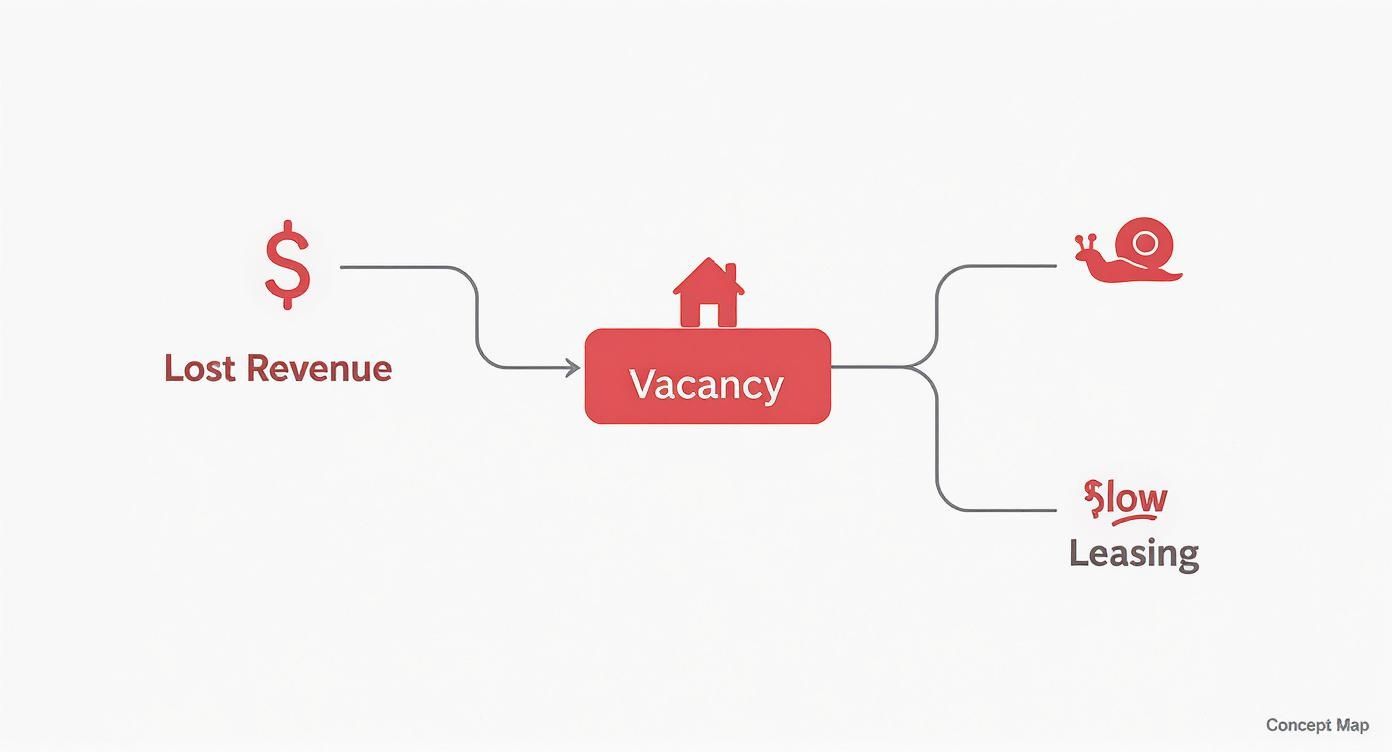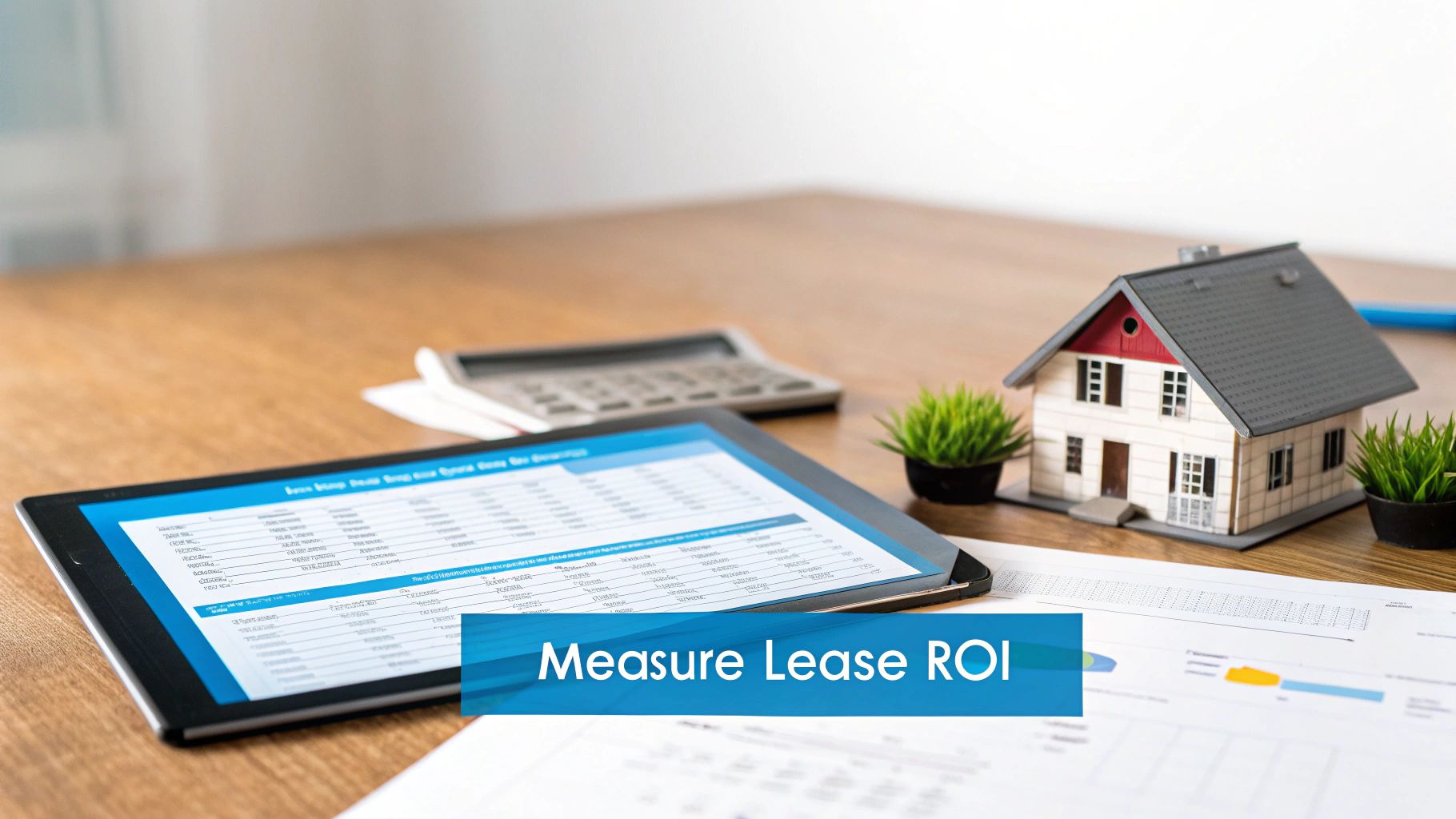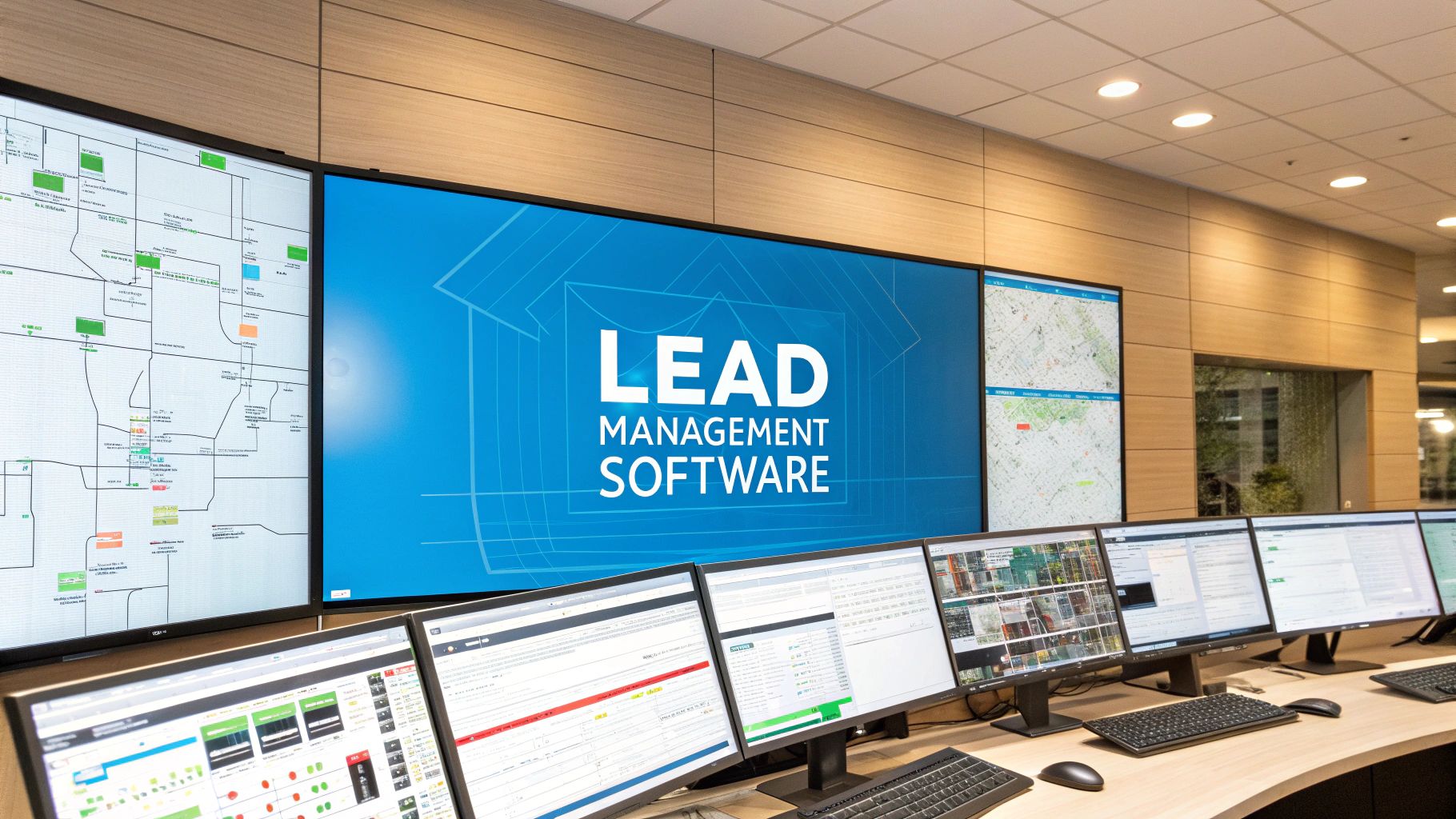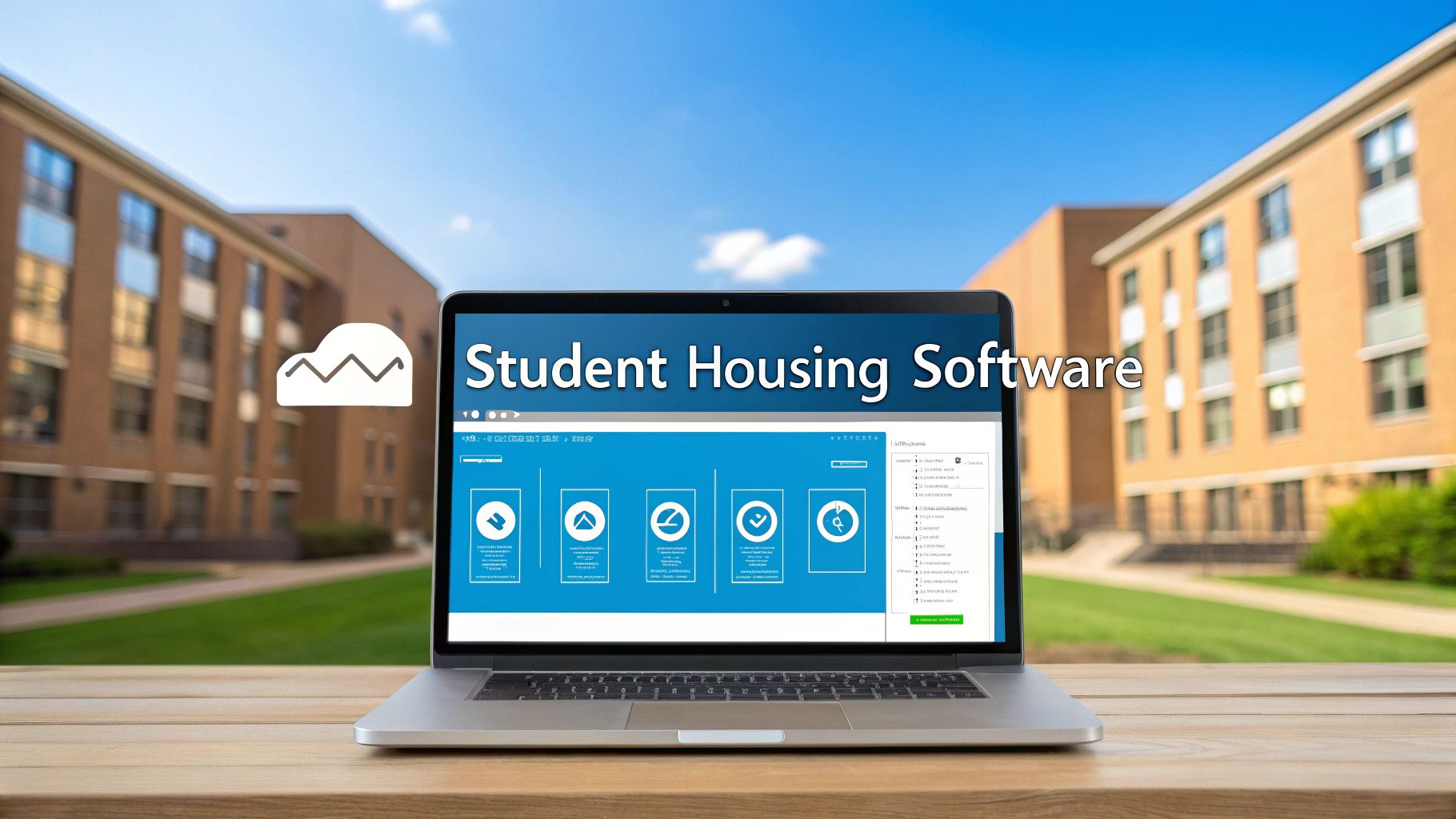Think of real estate lead management software as the central nervous system for your leasing operation. It’s a purpose-built tool designed to capture, organize, and automate every interaction with a prospective renter, from their first click to the signed lease. For property management companies juggling large, distributed portfolios, it’s what separates chaotic growth from scalable success.
Why Lead Management Is Critical for Scaling Portfolios
Once you’re managing 100, 1,000, or even 10,000+ units, tracking leads with spreadsheets and manual processes isn’t just inefficient—it’s a direct hit to your bottom line. Every missed call, slow reply, or fumbled tour request is revenue slipping through your fingers. At this scale, the flood of inquiries from Zillow, Apartments.com, and dozens of other sites can overwhelm even the most dedicated teams, making a scalable implementation framework essential.
The primary challenge for any large-scale operation is converting that flood of interest into signed leases as quickly as possible. This is where a metric called speed-to-lease becomes your most important Key Performance Indicator (KPI), directly impacting your revenue.
For property managers operating across multiple markets, speed-to-lease isn't just another number; it's the primary engine of profitability. The faster you convert a qualified prospect from an inquiry to a tour, the lower your vacancy costs and the healthier your portfolio's financial performance.
The True Cost of Inefficiency: A DOM Cost Analysis
A slow leasing cycle has a painful, compounding effect on revenue. Let's run a quick ROI calculation: if a single unit rents for $1,800 a month, one vacant day costs you $60. That might not seem like much, but multiply that across a 1,000-unit portfolio. Just one extra day of vacancy per unit, per year, adds up to a staggering $60,000 in lost revenue.
When you analyze the vacancy cost, it's clear that modern lead management software isn't a cost center. It's a revenue-generating machine.
This is exactly why the market for these tools is exploding. Valued at around USD 1.2 billion in 2023, the global real estate lead generation software market is on track to hit USD 3.5 billion by 2032. This isn't just hype; it's a direct response to the urgent need for operational efficiency in our industry.
Below is a simple comparison that highlights the financial difference between sticking with legacy methods and embracing modern automation, especially for a portfolio of 1,000+ units.
Manual vs Automated Lead Management: The Financial Impact
As the numbers show, automation isn’t just about convenience—it’s a strategic financial decision that directly protects and grows your revenue.
Adopting a System for Growth
Putting a powerful lead management system in place directly moves the needle on your most critical metrics:
- DOM Reduction at Scale: With instant, automated responses and self-service tour scheduling, you can shave days—or even weeks—off your leasing timeline.
- Cost Per Door Optimization: By systematizing follow-ups and automatically qualifying leads, you slash the labor hours spent on leasing each unit.
- Higher Lead-to-Tour Conversion: Engaging a hot lead within the first five minutes dramatically increases the chances they’ll book a tour with you instead of your competitor down the street.
And remember, a strong leasing funnel is only one part of the equation. To truly scale, it’s crucial to pair it with solid B2B lead generation strategies to keep your management portfolio growing.
For a deeper dive, check out our guide on how to get more property management leads for your business. Ultimately, a modern lead management system gives you the framework to handle explosive growth, standardize your processes across multi-market portfolios, and turn your leasing operation into a predictable, high-performance machine.
Core Features That Power Enterprise Leasing
Not all lead management software for real estate is created equal. When you're managing a portfolio of 1,000+ units, the generic tools most people use just can’t keep up. They weren't built for the sheer volume and complexity of multi-market property management.
Think of an enterprise-grade platform as the air traffic control for your entire leasing operation. It's designed to track every moving piece, ensuring no opportunity gets lost in the chaos. These systems come with a few non-negotiable features that are critical for managing remote property management operations and, most importantly, driving down your Days on Market (DOM).
Automated Lead Capture and Centralization
First things first, you need a system that can automatically pull in every single inquiry and drop it into one central dashboard. Leads come from everywhere—Zillow, Apartments.com, your own website, social media, you name it. A powerful system grabs them all in real-time.
This completely eliminates manual data entry, which is not only painfully slow but a magnet for human error. The second a lead is captured automatically, the clock starts on your speed-to-lease, giving your team an instant head start.
The infographic below shows exactly how old-school manual lead management bleeds money and slows down leasing cycles—problems that smart automation solves instantly.

It’s a stark reminder that every moment a property sits empty, it’s a direct hit to your bottom line. That's why having an automated, rapid-response system isn't just a nice-to-have; it's essential for property portfolio optimization.
Intelligent Routing and Instantaneous Response
Okay, so the lead is in the system. What happens next is what separates the pros from the amateurs. Enterprise software doesn't just sit on a lead; it acts on it immediately.
- Intelligent Lead Routing: The system is smart enough to assign leads to the right leasing agent or team. It can do this based on property location, who's available, or even which agents have the best performance stats. For property managers with multi-market portfolios, this is how you standardize processes across geographic regions.
- 24/7 Automated Responses: The best prospects often inquire after your team has gone home. A top-tier system shoots back an instant response via SMS and email, engaging renters when they're most interested. It can even let them pre-qualify themselves or schedule a tour on the spot.
Here's a number that should get the attention of any operations director: a response within the first five minutes can boost lead conversion rates by over 300%. When you're dealing with a large portfolio, that kind of speed is fundamental to hitting your occupancy targets and optimizing lead to tour conversion.
This is what a modern leasing platform looks like in action—a single hub to manage all your communication and scheduling, working around the clock so your team doesn't have to.
These two features are the bedrock of a powerful, scalable leasing engine. They ensure every inquiry is handled with speed and precision, setting the stage for a dramatically shorter DOM and a much smoother operation.
If you’re starting to compare different platforms, our breakdown of the 7 best leasing CRMs for your property management business is a great place to start. By zeroing in on these core functions, you can build a leasing process that actually supports your growth instead of holding it back.
Putting AI and Automation to Work in Leasing

Basic automation is great for getting leads in the door. But if you really want to turn your leasing process into a revenue-generating machine, you need AI for property management. For large portfolios, AI isn’t some far-off concept; it’s a practical tool that’s here now, helping property managers slash vacancy costs and boost efficiency.
Think of it this way: instead of treating every inquiry the same, an AI-powered system acts like a smart filter. It analyzes how a prospect interacts with your listings in real-time, figures out who is most likely to sign a lease, and pushes them to the top of the list. This lets your team focus their valuable time on the people who are ready to move.
From Data Points to Signed Leases
The real magic of AI in property management is how it turns a mountain of raw data into smart, actionable decisions. It goes way beyond simple "if this, then that" rules to actually predict which prospects are ready to see a property right now.
This kind of technology is what’s fueling the massive growth in the real estate software market. In fact, the industry is on track to blow past USD 10 billion globally by 2025, mostly thanks to AI platforms that handle everything from marketing to tenant communications. Data-driven leasing isn't a perk anymore; it's a must-have to stay competitive.
So, how does this look in a day-to-day leasing workflow?
- AI-Powered Lead Scoring: The system automatically looks at dozens of clues—how many listings a person viewed, the kinds of questions they ask, how fast they reply—and gives each lead a "hotness" score. The hottest leads get flagged for immediate follow-up.
- Predictive Analytics: AI is smart enough to spot patterns that show a renter is getting serious, like looking at the same floor plan multiple times or asking about move-in dates. When that happens, it can trigger a personalized, automated message to nudge them toward booking a tour.
- 24/7 Nurturing Workflows: AI assistants can chat with leads any time of day or night. They can answer basic questions, send property details, and guide prospects to the scheduling page—all without anyone on your team lifting a finger.
An AI-driven system doesn't just manage leads; it actively cultivates them. It makes sure your most qualified prospects are fast-tracked from their first click to a scheduled tour.
This proactive approach is the secret to getting more same-day showings and seriously improving your lead-to-tour conversion rates. You can see a great real-world example of this by learning about the benefits of using an AI leasing assistant like Showdigs’ Tori. At the end of the day, combining smart AI with automation is how the pros minimize vacancy loss and keep costs down across thousands of units.
How to Choose the Right Software for Your Portfolio
Picking the right lead management software for real estate is more than just a tech upgrade—it's a foundational decision that will define how you operate for years to come. For any operations director managing a large or distributed portfolio, this isn’t about chasing the longest feature list. It's about finding a strategic partner that can actually keep up with your growth and support remote property management operations.
The wrong choice will saddle you with data silos and frustrating bottlenecks. But the right one? That becomes the engine that drives down your Days on Market (DOM) and pushes your revenue higher. This calls for a clear-headed, data-driven approach to find a platform that solves today's leasing headaches and can easily handle a portfolio twice its current size.
Focus on Seamless System Integration
First things first: integration considerations are paramount for enterprise property management systems. Your lead management software can't be an island. It has to talk, seamlessly, with your core Property Management System (PMS), whether you're running on AppFolio, Yardi, RentManager, or another enterprise-level platform.
A solid, two-way API connection is completely non-negotiable. This is what keeps your unit availability, pricing, and prospect data synced in real-time, stamping out the soul-crushing manual data entry that cripples teams at scale. Without that constant, automated flow of information, your leasing team is essentially flying blind, leading to double-booked tours, inaccurate reports, and a poor prospect experience.
When vetting vendors, don't just ask if they integrate with your PMS—ask for a live demo of the API integration. A simple data import/export function is not enough. You need to see a dynamic, real-time sync that makes the platform a single source of truth for your whole leasing operation.
Prioritize Scalability and Remote Capabilities
A platform that works for 500 units might completely fall apart at 5,000. True scalability isn't just about handling more data; it's about maintaining speed and giving you the tools to manage properties across multiple markets without needing staff on the ground everywhere.
Your evaluation should put a heavy emphasis on features that empower a distributed portfolio:
- Centralized Dashboard: Can you get a bird's-eye view of leasing performance across every single market and property from one screen?
- Automated Lead Routing: Does the system intelligently route leads to regional teams or on-demand showing agents based on rules you can actually customize?
- Standardized Workflows: Can you build and enforce one consistent leasing process—from the first email to the signed lease—across your entire portfolio, no matter where the properties are?
These are the features that allow you to standardize quality control at scale. They ensure that a prospect in Austin gets the same fast, professional experience as a prospect in Boston. That consistency is the hallmark of a truly scalable, remote-first operation.
Demand Actionable Reporting and KPIs
Finally, you can't improve what you don't measure. Vague reports on lead volume are practically useless. An enterprise-grade platform has to deliver deep, actionable analytics on the leasing KPIs that directly tie back to your bottom line.
Don't settle for less. Insist on seeing dashboards that track:
- Lead-to-Tour Conversion Rates: Find out exactly where prospects are falling off in your funnel.
- Average Speed-to-Lease: Measure the clock from initial inquiry to signed lease for every unit.
- Cost-Per-Showing and Cost-Per-Lease: Get a real handle on the unit economics of your leasing activities.
- Agent and Source Performance: See which team members and marketing channels are actually delivering results.
Choosing the right software is really an investment in your operational backbone. By zeroing in on integration, scalability, and data-driven reporting, you can confidently select a platform that not only solves your problems today but is ready to fuel your portfolio's growth for years to come.
To help with this process, we've put together a checklist to guide your evaluation.
Enterprise Lead Management Software Evaluation Checklist
Use this checklist to systematically compare different platforms. It’s designed to help you look past the sales pitch and focus on the criteria that truly matter for managing a large-scale, multi-market portfolio.
Making the right choice requires diligence, but a structured evaluation process ensures you're selecting a partner for growth, not just a piece of software. A platform that checks these boxes will become a core asset in your operational toolkit.
Measuring Success and Calculating Your ROI

Implementing new lead management software for real estate is just the start. If you’re a property manager who lives and breathes by operational efficiency metrics, the real work begins when you have to prove its worth. At the end of the day, success isn’t about a long list of bells and whistles; it’s about making a real, positive impact on your portfolio’s bottom line.
Thankfully, modern platforms are built for this kind of scrutiny. They go way beyond just counting leads, giving you the hard data you need to track leasing velocity, nail down your cost-per-showing, and calculate a clear return on investment (ROI).
Calculating the Financial Impact of DOM Reduction
Days on Market (DOM) isn't just another metric on a spreadsheet—it's a direct measure of lost revenue. Every single day a unit sits empty, it's actively costing you money. Calculating this vacancy cost impact makes a powerful business case for investing in tech that shrinks your time-to-lease.
The math is simple, but the impact at scale is huge:
(Average Monthly Rent / 30 Days) x Total Units x Days Saved = Total Revenue Recovered
Let's plug in some real numbers. Imagine you manage a 1,000-unit portfolio with an average rent of $1,800. If new software helps you shave just five days off your average DOM, the results are jaw-dropping.
- ($1,800 / 30) = $60 lost per unit, per day
- $60 x 1,000 units = $60,000 lost across the portfolio every single day
- $60,000 x 5 days saved = $300,000 in recovered revenue
Suddenly, that software stops looking like an expense and starts looking like a strategic, revenue-generating machine.
Key Metrics to Track for a Clear ROI
Beyond DOM, a great analytics dashboard gives you a bird's-eye view of your entire leasing funnel. This is how you spot weak links and measure improvement over time. Here are the core metrics you should be watching:
- Lead-to-Tour Conversion Rate: This tells you how effectively you turn an inquiry into a property visit. A low number is a red flag for slow response times or a clunky scheduling process.
- Cost-Per-Lease: Add up your marketing spend and staff hours, then divide by the number of signed leases. This shows you the true cost of acquiring a new tenant and helps optimize cost per door.
- Leasing Velocity: This is the average time from initial lead to signed lease. It’s a holistic look at how efficient your entire process is.
- Source Performance: You need to know which listing sites and ad channels are sending you the best leads. This data lets you stop wasting money and double down on what works.
The right technology makes this data easy to find and understand, empowering you to make smart, data-backed decisions that drive portfolio performance. For example, some platforms have helped property management teams see a 60% jump in qualified leads while slashing operational costs by up to 60% by replacing manual busywork with smart automation. You can find out more about how teams are improving lead handling and conversion rates and see the difference for yourself.
Common Questions About Lead Management Software
Bringing a new technology platform into your workflow is a big deal, even when the ROI is crystal clear. For operations directors and portfolio managers, the devil is always in the details. Let's tackle the most common questions we hear from large-scale property management companies when they're looking at a modern lead management solution.
How Does Lead Management Software Integrate With Our Existing PMS?
This is usually the first—and most important—question. And for good reason. The best lead management software for real estate isn't a standalone island; it offers deep API integrations that plug right into major Property Management Systems like AppFolio, Yardi, and RentManager. This connection creates a two-way street, syncing property data, unit availability, and lead information in real-time.
For a large portfolio, this isn't just a nice-to-have, it's a must-have. It kills double data entry, stops those embarrassing scheduling mistakes, and creates a single source of truth for your whole leasing operation. Your team can work from one system without constantly toggling between platforms, which is huge for keeping your operational efficiency metrics in the green.
Can This Software Handle a Portfolio Spread Across Multiple States?
Absolutely. In fact, this is one of the biggest wins for multi-market property management and anyone scaling their remote property management operations. Modern software is built specifically to pull all incoming leads from different states and cities into one clean, unified dashboard.
For companies managing distributed portfolios, this is how you standardize processes at scale. A prospect in Texas receives the same high-quality, instant response as a prospect in Florida, ensuring brand consistency and operational control from a single hub.
You can even get more granular. Advanced features like automated lead routing can intelligently send inquiries to the right regional teams or on-demand agent networks based on the property's location. This lets you manage thousands of doors without needing boots on the ground in every single market, which directly boosts your cost per door efficiency.
What Is the Typical Impact on Days on Market We Can Expect?
While your mileage may vary depending on the market, property managers who implement automated systems often see a dramatic DOM reduction. The secret sauce is speed-to-lease. When you provide instant, 24/7 responses and let prospects book tours themselves, you shrink the leasing cycle from weeks down to just a few days.
The system cuts out the human delays—the endless games of phone tag and the slow email follow-ups. You're engaging hot leads within minutes of their inquiry, right when their interest is at its peak. This gets them in the door for a tour before your competitors have even had a chance to reply. It's not uncommon for large portfolios to report DOM reductions of 30-50% after fully rolling out an automated lead management and showing platform.
Ready to see how much you can slash your Days on Market and pump up your lead-to-tour conversion rates? Showdigs provides the AI-backed leasing automation platform designed to turn your leasing operations into a high-performance, revenue-generating engine.







